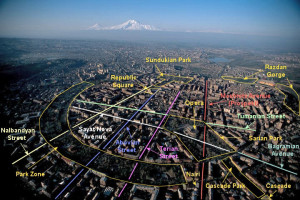
The street had a resemblance of the 19 to 20th century’s architectural style. You could see 1-2 stored residential buildings constructed mainly from tuff and brick, with internal yards. One of the famous houses belonged to the bailiff O. Grigoryan, which was surrounded with shops (nowadays it is located on 2 P. Buzand Street).
Behboutovskaya Street was also famous for ARF Supreme Council Office, Yerevan branch, and accordingly the street got the name of a famous revolutionary figure Simon Zavaryan in 1920. In 1921 it was renamed Rouben, another revolutionary figure of that time, later Sverdlov, and at last, in 1990s the street was named Pavstos Buzand. Pavstos Buzand had a distinguished architectural style with the splendid gardens, pantries, swimming pools that belonged to the rich residents of the street.
Unfortunately, the street does not have the historical character, due to the widespread construction works often held in the city, and particularly with the construction of Northern Avenue, however, it is planned to become an architectural district with the name “Old Yerevan”, which will be located between Buzand and Arami Streets. The house was the first street corner building of Behboutovskaya Street, where you could also find the first publishing house.
f I he promotion and preservation of the VJ local cultural heritage and tradition is a C/ problem number one in the 21st century of digital technologies. These initiatives served as a prime goal of how “Erkir Nairi” Travel Company organized a special tour to Lake Sevan on Vardavar on July 11, 2010.
Hasmik Harutyunyan, who is one of the tour activists, told us the details of the special tour organized by “Erkir Nairi” Travel Company. By the way, she is the soloist of “Shoghakn” Folk Ensemble in Armenia.
It is known that Vardavar is an Armenian holiday, which dates back to the pagan times. In pagan Armenia, the holiday symbolized “adoration to water” and was related to goddess of love and beauty Astghik. After adoption of Christianity in 301 B.C. the holiday was replaced with the Christ’s Transfiguration day. According to Hasmik Harutyunyan; “While celebrating the event we somehow diverge from Christian part of Vardavar and completely focus on the traditional part, as we have a rich cultural heritage and traditions and customs are the part of it, moreover, I’d say the most important features, which need to be applied in reality just during the holiday celebration.”
Therefore, early in the morning of July 11 we left for Lake Sevan, where the event took place. On the way, the appropriate guide told us the history of Vardavar beginning from the ancient times up to these days.
She quoted the dialogue of Hayk and Bell from the legend, as well as the goddess of love
and beauty Astghik and Anahit. One of the most important parts of the event was the so-called “dashtahandes” when the participants pluck flowers and wheat from the fields to make wreaths out of them, accompanied with songs and dances of ethnographical ensemble. Afterward, some Khachburs were made out of these flowers and the ripe ears of wheat, which symbolize the Life Tree. All these were taken home after being blessed at the church, as Khachbur and the Life Tree, as well as the apple, some vegetable and leaflets of roses are the main symbols of Vardavar. After dousing each other with water, the participants began to taste the delicious dishes brought with them: matagh – this is the main dish usually served at Vardavar.
One more thing to notify, the tourists were more flexible and energetic during the event than the locals, as they re strongly attracted with every detail connected with the holiday. All the same, the feast of Christ’s Transfiguration is in the past, but we have many pleasure impressions from the holiday.
Pavstos Buzand Street
Back To Top










